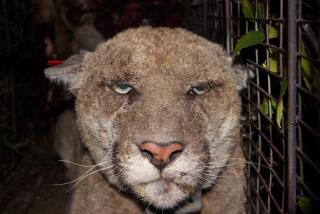Caltrans Hit Man : To Biologist, Cowbird in Trap Better Than Any in Wild
- Share via
Some Caltrans workers build sturdy concrete bridges, some design ribbons of million-dollar-a-mile highways, some survey uncharted routes through rugged terrain.
John Rieger catches cowbirds.
But no one snickers at Rieger’s pursuit of the lowly cowbird because more than one of the state Department of Transportation’s major projects would have been stopped dead in its tractor tracks without his expertise.
As a Caltrans district biologist, Rieger creates mitigation programs to offset the damage that Caltrans’ roadways and bridges create among endangered species’ habitats.
At present, Rieger’s target is the brown-headed cowbird--a bit larger than a sparrow, which the females resemble, and smaller than a blackbird, which the males resemble. The cowbird has a nasty habit of laying its eggs in other birds’ nests and leaving the hatching and rearing to others. But when cowbirds choose the nests of the endangered least Bell’s vireo, a tiny vanishing species, the vireo often abandons its nest, leaving the cowbird egg and its own eggs to perish.
When Caltrans was required to mitigate its damage to least Bell’s vireo habitat in the building of a new bridge on California 94 over the Sweetwater River near Jamul, Rieger went into action. He borrowed and baited bird traps, then designed his own.
Early last year, he began to trap cowbirds around the bridge site and at a nearby stables. He released most of the male cowbirds--except for a few kept in the traps as lures to the females--and exterminated the captured females, thus making life less complicated for the vireo and allowing his fellow Caltrans workers to proceed with their bridge-building.
The U.S. Army Corps of Engineers, which required the mitigation program, is satisfied with Rieger’s methods and results, but Rieger is not. He is honing his skills at cowbird-catching to a point that could turn the common barnyard resident into an endangered species itself.
The mitigation program along the Sweetwater River is at its peak this spring. Rieger’s traps are aflutter with hapless cowbirds. Rieger now knows where to trap the birds, when to trap them and, most importantly, how to track them in the future.
When his California 94 cowbird-trapping obligation ends in August, Rieger will move his 20 huge cowbird traps and his San Diego State University consultants to the North County to assault the dreaded cowbird colonies along the San Luis Rey River. Already, he knows more about the San Luis Rey cowbirds than anyone else.
Crews in the field have been tagging the birds with colors to identify where they were trapped.
Next year, when the trapping program begins along the San Luis Rey because the Bonsall Bridge on California 76 north of Vista is being rebuilt, Rieger will launch his assault at the foraging grounds of the cowbird--the stables, dairies, farms and feed lots within a few miles of the river.
The cowbird got its name because it hangs around cattle and horses, probably because of the wealth of insects and grain around such animals. So Rieger has plans to spot his 6-by-8-foot traps where the action is. His San Luis Rey trapping spots appear to be the Whelan Ranch dairy and two others farther upriver, near the Bonsall Bridge.
Rieger and an SDSU student consultant, John Beezley, have written a paper presented at an ornithological society meeting and soon to be published in the magazine, California Birds, which contains some insights into cowbird habits.
For instance, the females are sociable, often holding afternoon “hen parties” in a foraging area. And males, jealous of their harem, often skip out on their male duties for a snack.
Rieger’s traps will be placed to cater to these cowbird habits. His scientific paper hints that other federal and state agencies trapping in the San Diego area might do well to follow his example, possibly baiting the cowbird traps with females as well as male decoys to take advantage of their afternoon soirees, and by putting the traps in feeding areas rather than in river valleys.
His research has indicated that cowbirds’ habit of laying eggs in other birds’ nests results in a 30% hatch loss among Bell’s vireo. However, Rieger says, the endangered birds may compensate by building a second nest and hatching a second batch of eggs.
Because the vireo builds its nests within a few feet of the ground, it has a host of predators besides the cowbird. Snakes, cats, possums, skunks and weasels also take a 30% toll of the vireo’s eggs and young.
Added to the habitat destruction caused by humans--including Caltrans--the vireo’s existence depends on the success of Rieger and others in wiping out the parasitic cowbird to give the tiny endangered birds a chance to reproduce.
More to Read
Sign up for Essential California
The most important California stories and recommendations in your inbox every morning.
You may occasionally receive promotional content from the Los Angeles Times.










